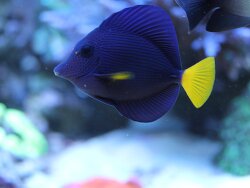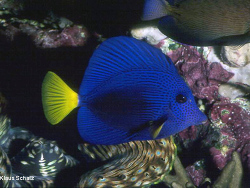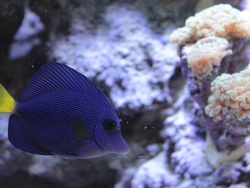Info
Also known as Zebrasoma xanthurum... not quite so good, and therefore not as easily to socialize as the yellow doctor. Among this species, there are several ruffians that may harm every fish, that comes after them into the tank. When introduced into a tank as juvenile it usually acclimates well. Needs clean and oxygen-rich water and ample swimming space and a lot of vegetable food. Putting a second zebrasoma may go smoothly from time to time, according to tank size and fish... with us it has worked out and the two specimen have come along with each other well for three years already. Can be held in sufficiently big tanks in a group, if you intend to do so, then you should introduce several juvenile specimen at the same time.
Blue sailfin surgeonfish (Zebrasoma xanthurum), also called yellowtail sailfish, is a species of the surgeonfish family. This surgeonfish is also known as Zebrasoma xanthurus just in aquarium tours....
It reaches a length of up to 25 cm and thus becomes larger than the well-known "yellow Hawaii Doctor" On the tail root there are typically scalpels or horn blades.
From my own experience, not quite as well-behaved as others, and thus not as easy to socialize as, for example, the yellow doctor. In this species there are in my opinion quite a few bullies, which attack everything that comes into the tank after them. On the other hand it is quite easy to get used to the aquarium life when it is still small.
Needs like all Doctors clean and oxygen-rich water and in addition much swimming space supplemented with much vegetable food, he is an "algae growth eater".
Adding more fish is sometimes possible, depending on the size of the tank and the type of fish... With us it worked, the two get along today splendidly, and that already 3 years long. Can be kept in a group in sufficiently large tanks, if you plan to do so, then you should introduce all fish at the same time, and that preferably with small animals.
The blue sailfin doctor shows his dark blue color only when he feels well!
Synonyms:
Acanthurus xanthurus Blyth, 1852
Zebrasoma xanthurus (Blyth, 1852)
Classification: Biota > Animalia (Kingdom) > Chordata (Phylum) > Vertebrata (Subphylum) > Gnathostomata (Superclass) > Pisces (Superclass) > Actinopterygii (Class) > Perciformes (Order) > Acanthuridae (Family) > Acanthurinae (Subfamily) > Zebrasoma (Genus)
The surgeonfishes (Acanthuridae), popular in marine aquaristics, are also called surgeonfishes.
They have horn-like blades in front of the tail root, they use as mainly defensive weapon (defense) against predators, but this sharp weapon is also used in fights among themselves.
Deep cuts in the body of opponents can cause permanent injuries, but often death occurs immediately.
If surgeonfishes are to be kept in pairs in an aquarium, fights between the fishes can be the order of the day, we could observe this several times with the very popular Hawaiian surgeonfish (Zebrasoma flavescens).
The scalpel-like blades can cause deep cuts, this is also true for the careless aquarist who wants to touch or catch the fish with unprotected hands.
Another problem can occur if one wants to catch surgeonfish with a landing net and transfer them after catching, the horn blade can easily get caught in the net.
Caution: Careless handling of the animal can cause deep cuts!







 Anne Frijsinger & Mat Vestjens, Holland
Anne Frijsinger & Mat Vestjens, Holland




























